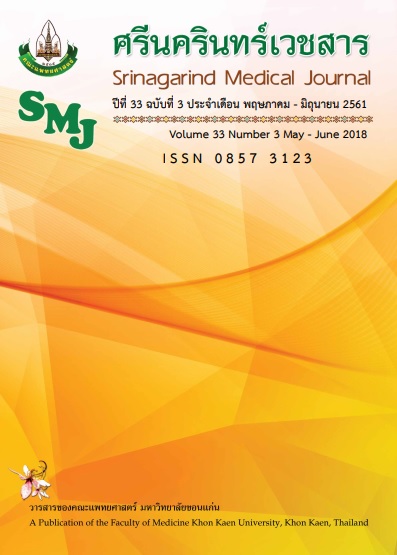Bio-Control of Burkholderia pseudomallei in Soil by Bacillus amyloliquefaciens
บทคัดย่อ
Background and Objectives: Burkholderia pseudomallei, a Gram-negative bacterium causes a disease called Melioidosis. It is mostly found in soil and stagnant water in endemic areas. B. amyloliquefaciens N3-8 was isolated from soil and its secondary metabolites can kill B. pseudomallei that may be used to control B. pseudomallei in soil.
Methods: B. pseudomallei p37 and B. amyloliquefaciens N3-8 were separately cultured to obtain 1x 106and 1X109 CFU.mL-1. Then mixed B. pseudomallei p37: B. amyloliquefaciens N3-8 with 1:50, 1:100 and 1:300 ratios of cell into 10 g of soil and incubated at room temperature for 4 weeks. The soil has pH=6.98.
Results: The ratio of 1:300 can reduce the number of B. pseudomallei p37 in soil starting from the second week. The pH of soil in the presence of B. amyloliquefaciens N3-8 was significantly increased when compared at the beginning with the 4th week (p< 0.01). At the end, soil with B. pseudomallei p37 had pH = 7.35±0.05, soil with B. amyloliquefaciens N3-8 had pH = 8.26 ±0.06, soil with ratios of 1:50, 1:100 and 1:300 had pH = 8.08 ±0.05, 8.03 ±0.05 and 8.81 ±0.05.
Conclusions: B. amyloliquefaciens N3-8 at 1:300 ratio can clearly reduce the number of B. pseudomallei p37 in soil. Further investigation in natural soil environment could support the potential use of B. amyloliquefaciensN3-8 as a bio-control to reduce B. pseudomallei in endemic areas
การควบคุม Burkholderia pseudomallei ในดินด้วยวิธีทางชีวภาพโดย Bacillus amyloliquefaciens
โชติมา โพธิทรัพย์1,3, บุษปวัน โสภณฤทธิเดช1,3, สุรศักดิ์ วงศ์รัตนชีวิน2,3, รศนา เสริมสวรรค์1,3*
1ภาควิชา ชีวเคมี คณะแพทยศาสตร์ มหาวิทยาลัยขอนแก่น
2ภาควิชา จุลชีววิทยา คณะแพทยศาสตร์ มหาวิทยาลัยขอนแก่น
3ศูนย์วิจัยโรคเมลิออยโดสิส คณะแพทยศาสตร์ มหาวิทยาลัยขอนแก่น
หลักการและวัตถุประสงค์: Burkholderia pseudomallei เป็นแบคทีเรียแกรมลบที่ก่อให้เกิดโรคเมลิออยด์ พบได้ในดินและน้ำของบริเวณที่เป็นแหล่งระบาด ส่วน Bacillus amyloliquefacients N3-8 ที่แยกจากดินผลิตสารทุติยภูมิที่มีผลฆ่า B. Pseudomalleiได้ในอาหารเลี้ยงเชื้อ จึงนำมาใช้ควบคุมปริมาณ B. pseudomalleiในดิน
วิธีการศึกษา: เลี้ยงเชื้อ B. pseudomallei p37 และ B. amyloliquefaciens N3-8 ให้ได้ 1x106 และ 1x109 CFU.mL-1ในอาหารเหลว นำมาผสมในอัตราส่วนเซลล์ B. pseudomallei: B. amyloliquefaciens เท่ากับ 1:50, 1:100 และ 1:300 ในดิน10 กรัม pH ดินเริ่มต้นเท่ากับ 6.98 บ่มไว้ที่อุณหภูมิห้อง 4 สัปดาห์
ผลการศึกษา: พบว่า อัตราส่วน 1:300 ของ B. amyloliquefaciens N3-8 สามารถลดจำนวนของ B. pseudomallei p37 ในดินอย่างชัดเจน ในสัปดาห์ที่ 2 โดย pH ของดินที่มี B. amyloliquefaciens N3-8 เมื่อเปรียบเทียบระหว่างสัปดาห์ที่ 0 กับ 4 มีค่าเพิ่มขึ้นอย่างมีนัยสำคัญ (p < 0.01) ในสัปดาห์ที่ 4 ดินที่มี B. pseudomallei p37 ค่า pH = 7.35±0.05 ดินที่มี B. amyloliquefaciens N3-8 มี pH = 8.26±0.06 ดินที่มีB. Pseudomalleip 37 ร่วมกับ B. amyloliquefaciens N3-8 อัตราส่วนเซลล์ 1:50, 1:100 และ 1:300 มีค่า pH =8.08 ±0.05, 8.03 ±0.05 และ 8.81 ±0.05
สรุป: B. amyloliquefaciens N3-8 ในสัดส่วน 1:300 สามารถลดปริมาณ B. pseudomallei p37ในดินได้ชัดเจน การทดสอบเพิ่มในดินธรรมชาติ จะช่วยประเมินศักยภาพการนำไปประยุกต์ใช้ลดปริมาณ B. pseudomalleiในพื้นที่ระบาดได้




